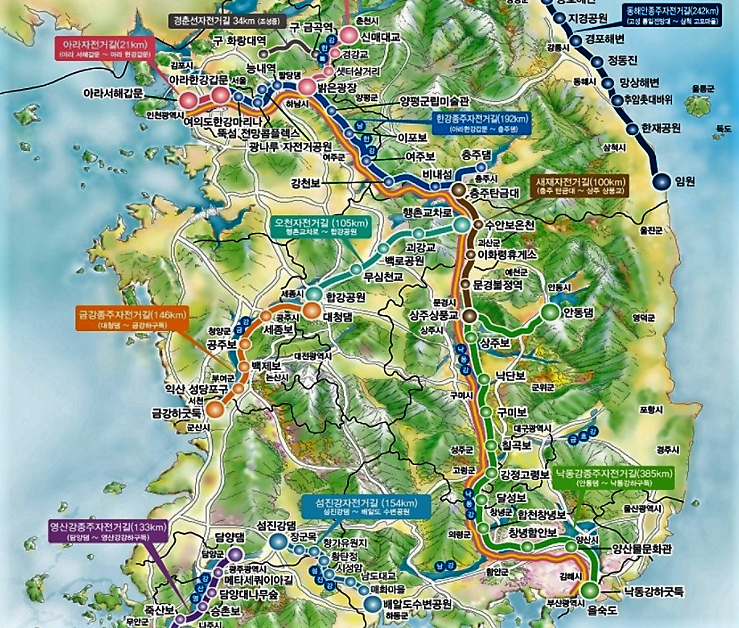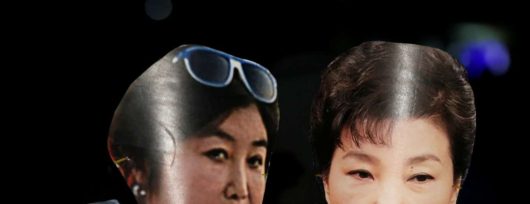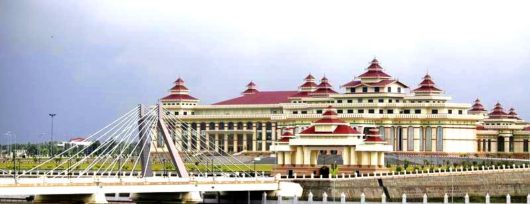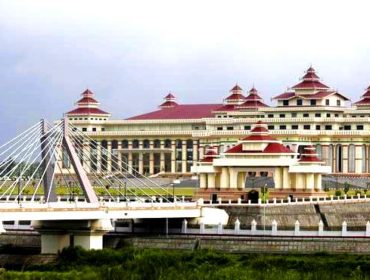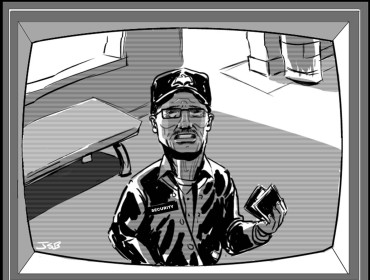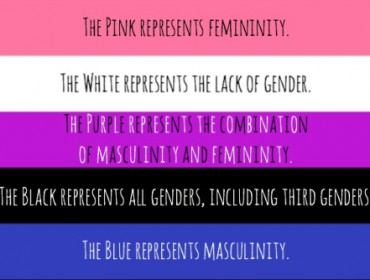By Jenna Kunze
I had never ridden by bike further than the next neighborhood over before I embarked on a cycling trip that would take me across a country I’d just moved to, with people I’d just met.
The trail that connects Seoul to Busan is called the “Han 4 Rivers Trail,” a namesake derived from, yes, the four rivers that string together the world’s longest biking trail (a non-verified claim). It was opened in 2011 as a $17 billion undertaking. The trail follows the Han, Daejeon, Guem, Nakdong, and Yeongsang rivers. Connecting the two largest cities in Korea, Seoul and Busan, the path also snakes through the fourth largest metropolitan area of Daegu.
In five days, we covered 340.5 miles (548 km).
***
“We need to eat something every hour or all of the sugar will deplete from our muscles and we’ll do this thing called boiking–it’s like–it’s when you just die, basically,”Matt said as he guided his bike by bracing the frame with his thighs, hands unwrapping a Binch cookie and passing it to me.
By contrast, even lifting one hand off my handlebar to receive the food he so confidently prepared for eating made my whole body ossify in the beginning. But everything was harder in the beginning.
I joined this lengthy bike trip across Korea over a vodka-infused conversation within an hour of meeting Matt a few weeks earlier. His presentation of the trip was so nonchalant–“Yeah I think I’m just going to go on this bike trail for a few days”–that I was continuously shocked when he swapped the word “biking” for it’s uppity cousin, “cycling,” referencing sport-specific vocab, and traded the Drake t-shirt I met him in for a singlet and shoes that locked into his petals.
The barometer with which I measure my decisions, I’ve learned, seems to center on “the outrageous.” I’m less apt to agree to anything less, and anything more prompts more careful consideration (like hiking Fuji in the middle of winter when the official trail is closed and all professional websites warn imminent death). Usually, if I can’t say something without laughing, or striking a look of disbelief in someone’s face, I know I’m making a venerable decision. This logic is what led me to work as a club promoter in Italy for a summer, to sign up to run a marathon four weeks in advance, and ultimately to ride a bicycle across a country I’d just arrived to.
I extended the invite to Haley, my new co-worker. She laughed at the proposition as she blew out cigarette smoke, and said “sure.”
“We probably won’t make it,” I prefaced all conversations leading up to our trip with. “Far, yeah,” I’d agree with every single person who gawked and our absurd plan. Several blog posts (a personal favorite, the “Cyclopaths”) from experienced riders who’d completed the trail warned it would take five full days of hard biking to make it to Busan. We had four and a half. ”Not experienced, no,” I’d laugh at my own expense in unison. We’ll see how it goes, we probably won’t make it.
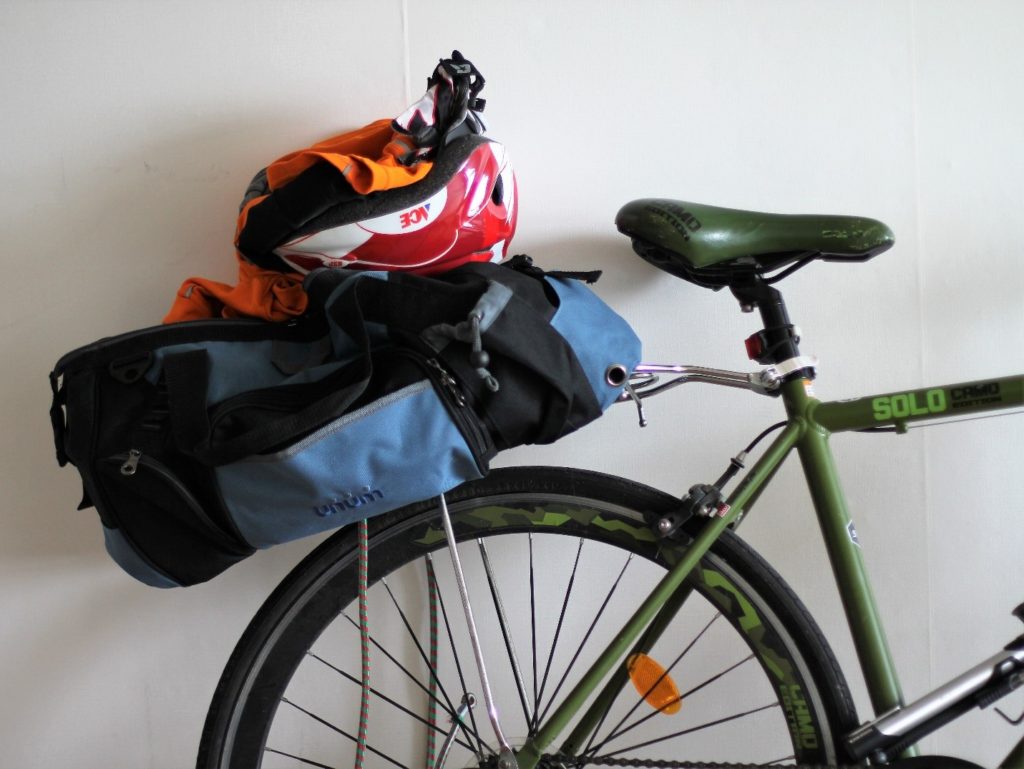
We began the trip around 2 p.m. on a Wednesday and took the subway to the furthest east point of the trail accessible by subway, Namyangju, and started biking. We didn’t stop for four and a half days.
I mean, we stopped, of course. Just never for longer than an hour at a time during daylight hours, and only for practical reasons, like eating and sleeping (though in periods of delirium practical became more interpretive–read on).
Biking became the constant, and I don’t think it’s at all dramatic to compare it to the reflexive behavior of breathing at the time. With all the empty hours, we played word games, gave indirect character witnesses through stories (remember, we all just met) and pointed a lot. “Look at that field!” “Do you see that bridge that looks like it’s from a weird future sci-fi movie?” I became more comfortable with one-hand steering for the express reason of having to point so much. We drank water, and fought about not drinking enough water (me, always). I relished the fact that sugar was necessary to stave off, you know, “boiking,” and was happy to introduce gallons of Pocari Sweat, Coca Cola, and endless packets of cookies into a 4.5 day diet plan.
With our backpacks strapped to contortion on our bike racks, Haley and I relied on Matt and his one, orange singlet with pockets like a clown car. We’d buy entire boxes of cookies, granola bars, and sweet cakes and then promptly stretch the pocket out wide and dump them in. Luckily, too, because neither Haley nor I would have been nearly as regimented about our feeding times. “I can’t do it,” Haley would moan as he coasted next to her, offering her the same cookie she’d eaten 35 minutes ago.
Now half-a-year removed from the trip, I am not able to excavate town names from my brain to delineate the trail to prospective riders. Maybe because I barely knew them to begin with. Matt was the soul navigator, whose map-my-ride log following our whole trip has since been lost with the death of his iPhone. I won’t say this responsibility was easy, but most all of the trail was expertly marked, and there were only intermittently short periods we spent off the trail.
Instead of town names, the landmarks I remember are people, kind and peculiar, and odds and ends of places strung together that map our trip as a whole. I can recall where we ate on a certain day based on distinct and visceral memories of how easy it was for us to walk at the time. I remember the exact layout of a chicken place we stumbled into for our third dinner, because we sat on the same side of the table to lean together, taking pressure off of our butts and budding saddle sores.
We followed a cartoonish four-leaf-clover logo that marked the 4-rivers-trail throughout the country. It was our north star directing us south, and there was at least a 24-hour period during which I would have gotten it tattooed on my body. Whenever hunger or nightfall required us to divert from the river path, we’d scour signs from a distance, looking for those four, multi-colored petals. The path itself was distinctive, too, putty red with the look of a high school track.
Bikers have several options for lodging along the trail. The most suitable are love motels, Korea’s claim on the motel industry, that charge by the hour and provide you with a condom and a room key upon check-in. Many bloggers also wrote about camping at various grounds along the trail, which we had neither the equipment nor the mule-packing carrying power for. Also, there are pensions, which are traditional guesthouses where you typically sleep on a sleeping mat on the floor and meals are provided.
We stayed at love motels, which were generally the easiest to find in a new town. Each morning began the same, with a 6 a.m.-we-will-sometimes-snooze alarm, and each night finished with a beer over a hot meal. Tracking out of our room each morning, we’d leave behind various bottles and cans, weightless and teetering on the entire surface of a dresser.
There were trees, my god there were trees, and so many rice fields of ice pop lime-green. Rice accounts for 90% of total grain production among the 1.1 million farm households in South Korea. The average cultivated area is 1.5 ha/household, or 3.7 acres, so it is perfectly logical for rice fields to be the looped scene in my head when I think about the middle of South Korea. Often, we’d be the only souls for miles and miles, winding through and around these impressive rice fields.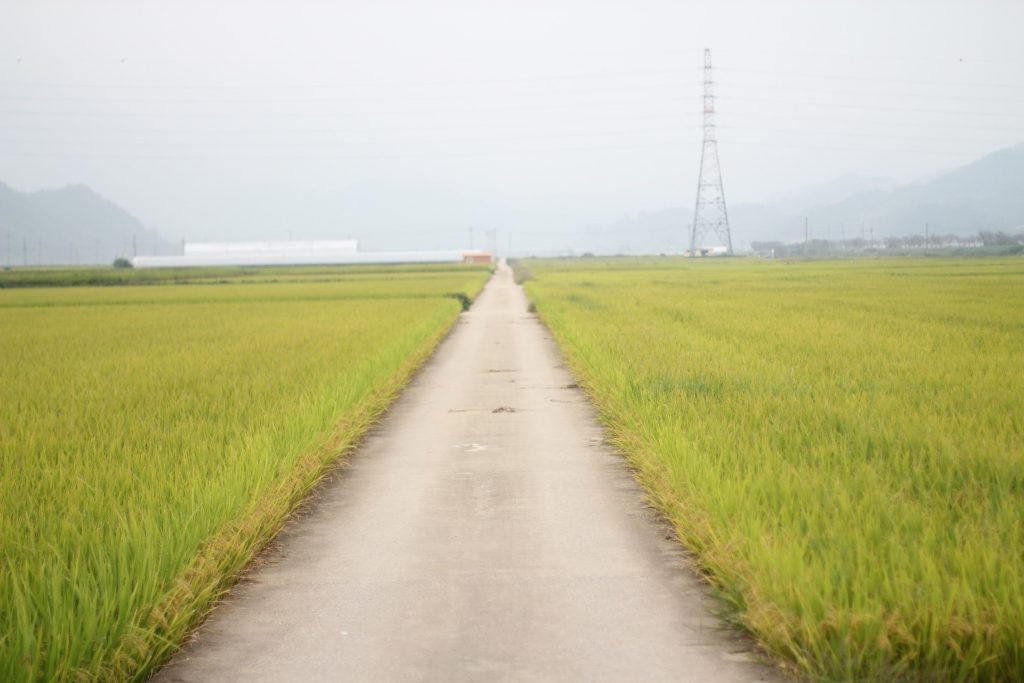
We called ourselves the Seouldiars, after sifting through even cornier team names. Almost just as we hit our stride on the third day, though, Haley was on a bus back to Seoul with a beer-can icepack on her knee (Matt’s solution to everything). It had been bothering her, which she stoically had not yet vocalized, and we were in for a day of hills.
Hesitantly, a bit disoriented from the breakup of our team, Matt and I pushed forward towards Daegu, and a forecast from hell. Our preliminary research outlined three hills we’d have to climb en route, and their slow incline made the speed of my pedaling match the slow resistance building inside of me. My knees would sometimes lock and I’d have to gear down or fall off–both tactics I tried. Somewhere around the first hill, Matt took out his phone in an act of solidarity. Kanye’s “Blood On the Leaves” became the blaring mantra, a sound that could only be heard from his feeble phone speaker if I was just behind him, which furthered my incentive to stomp against my wheels, swiveling my airborne hips from side to side for maximum momentum.
“Fighting!!” was the first colloquialism I learned in Korean from this first hill. A phrase that means the English-equivalent of “you can do it!!” I heard this affirmation again and again from Korean biker’s whizzing by downhill, and eventually started chanting it myself. Today, it’s something my Korean co-workers sometimes drop on me before a hard task, and it makes me feel sick with nostalgia. It’s a word that sounds best when torn apart by wind and paired with a stranger’s smile–of which we saw a lot. Strangers’ smiles, that is.
The one time we didn’t stay at a love motel was the third night, when we met Jaekil and his family. It had rained all afternoon and the mountain was eclipsing the light, the next town anywhere between 15-50 miles ahead. Matt’s iPhone map was so general, we never really knew distance, which was at once a blessing and a curse. So we asked these fellow bikers for directions; a man, what looked like his wife, and teenage son. They were all wearing slick ponchos that covered both themselves and their belongings, and urged us to follow them. We did–to a biker’s pension, down a half-mile dirt road and into a community of bikers. We ate kimchi and rice dinner with Jaekil and his family, and later breakfast of the same food. He drew us a map in Korean on scrap cardboard that now hangs on my wall as a memento of how to bypass an upcoming mountain to save time on our next day’s journey.
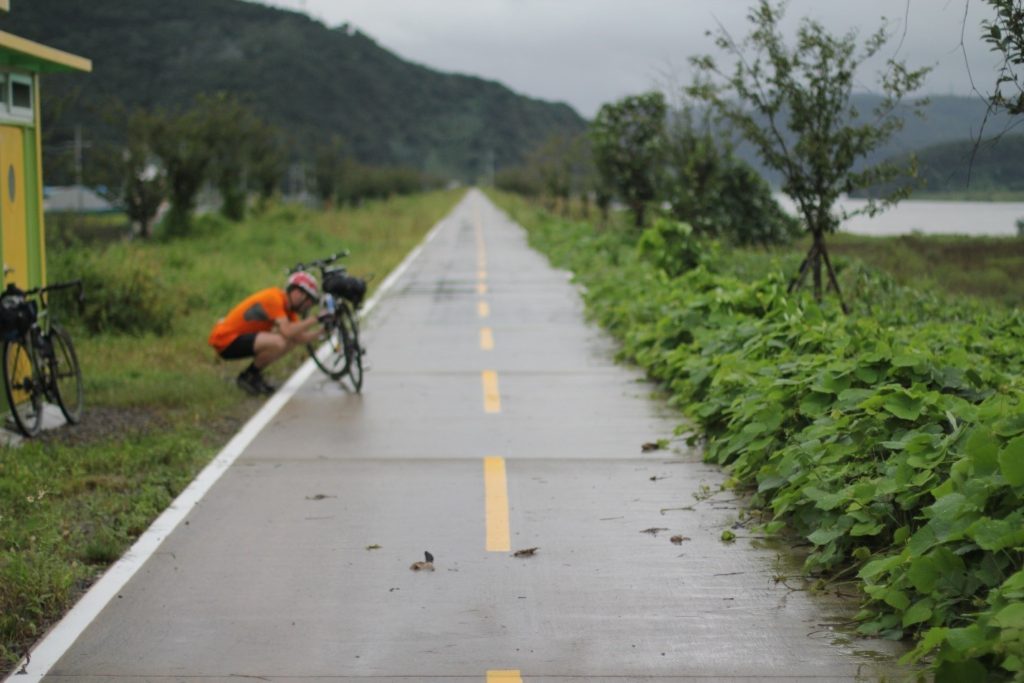
Of all the days that bleed into one another on the trip–Which day did we stop at that campground rest area? Where did we get lost and senselessly summit that mountain?–the stand-alone distinction was the fourth day. From the time I opened my eyes on Saturday morning, not to the usual alarm symphony, but to pelting raindrops on the thin roof above, I can recount each, drenched detail. It wasn’t just raining, it was pouring. The same rain that came down like a faucet on full came back up through tires that created spin-art designs of dirt on our legs. This day would be the tell-all day to make up time and make it, or not, to Busan. So, we packaged our still-damp-from-hand washing clothing, and headed out.
We agreed to the logic that stopping would only make us cold, so our first stop was only out of necessity to re-stock on fluids. We landed just off the trail in nowhere land Korea, at a no name Korean convenience store with Porta Potties out back and outdoor seating on a plastic-encased deck. The ajumma that worked there was not concerned about her floors, which were now specked with fat splats of water and muddy footprints. Instead, she simply could not understand why we weren’t wearing jackets. When we arrived, while we ate, and before we left, she spewed Korean at us, wildly gesticulating and rubbing each arm with the other so fast she was a blur of motion. “Busan” we told her, which only made her more confused and concerned. It seemed the closer we got to Busan, the more skeptical the townspeople we encountered were about our making it. The look on her face indicated doubt and bewilderment. Worried now about our mental states in addition to physical, she followed us out and waved in big half-rainbows as we walked our bikes back the way we’d come.
Getting back on my wet, cold bike while my muscles twitched and jittered with clear warnings was the lowest point of the trip. “I didn’t think you were going to make it from there,” Matt would later admit to me. “You looked pissed.” And I was. I was that unshakable, unavoidable cold that could only be thwarted with a hot shower and layers and layers of clothes. Would you rather be too hot or too cold was, in my opinion, the easiest question to answer. Sure, you can always put layers on when you’re cold but can’t take them off when you’re hot. Even still, there’s the irreversible quality of being cold–on a ski slope, camping–that is severe and dangerous, that just isn’t present in summer months.
As an investment in our health and happiness, Matt invented a hot pack at our second stop that would save our lives, if not nearly seer off our skin. He filled an empty aluminum coffee bottle with hot water. It was too hot to touch without first wrapping your shirt around it, which we took turns doing for the rest of the day while biking. Another necessary cause for one-handing it.
We would do this thing, (I forget what Matt called it, maybe crushing it?) where we’d pedal as fast as we could as fast as we could for several minutes to get out muscles warmed and blood circulating to all the vital places. We talked about everything but the rain.
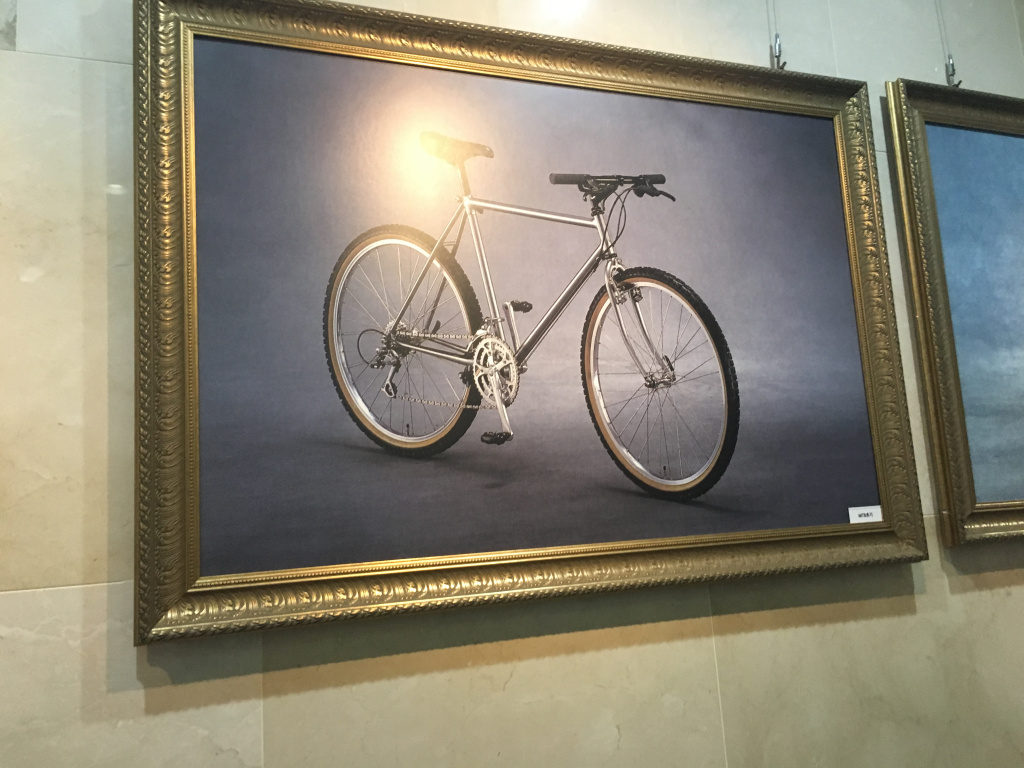 At one point, we happened upon a bike museum. No kidding. The Sanju Bicycle Museum. We had to stop, we couldn’t stop laughing, and the museum itself was so outrageous. A massive structure, it had lots of empty space, and still-life portraits under heavy spotlights of three-gear bikes just like mine.
At one point, we happened upon a bike museum. No kidding. The Sanju Bicycle Museum. We had to stop, we couldn’t stop laughing, and the museum itself was so outrageous. A massive structure, it had lots of empty space, and still-life portraits under heavy spotlights of three-gear bikes just like mine.
What I love about the story that substantiates just how much it poured on the day of hell is, the next day, the trail was closed from flooding in several different places. Flooding you’d have to see to believe, entire bits of our established trail just blipped off the radar, swallowed whole by the river to the right. It validates just how much rain my clothes absorbed, was spit up back at me by my tires, made my bike a mirror of refracted light.
We knew we’d make it to Busan by the morning of the last day. Just 100 miles away.
I was struck by the change of the trees. Once woody and large, these southern trees were stout, with big knobby growths on their sides.
There were roadblocks, sure. Often literally. Just three hours from Busan, the whole trail was closed off from flooding and we had to follow verbal directions from the Korean girls holding traffic signs, up over yet another hill to reconnect with the non-submerged trail. There was the getting lost, the going the wrong way, and the unsightly development of “saddle sores” on our butts and thighs from the precarious extended positions we were putting them in. There was sailing over handlebars in the countryside when an ajumma doubled back to her car without looking. There’s the chunk still missing from Matt’s knee from falling hard and fast on gravel while talking about his weed habits in high school.
But for every hard thing there were 10 gifts: the full-figured apples I ate directly off a tree; the kind man who turned around, stopped the car, and came out into the rain to ask us (in broken English) if we needed directions; the weird exchange of snacks and then testosterone between Matt and this Korean male who proceeded to race him a mile ahead of me; the picturesque attitude of the man perched on a guardrail, fishing. Gifts.
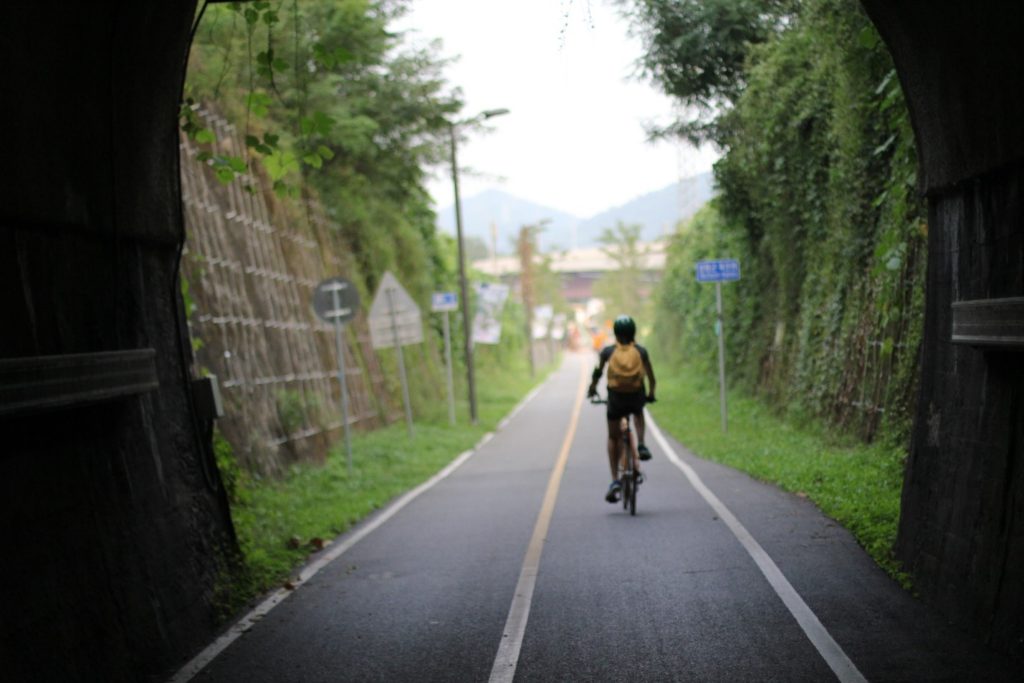
We were in Busan for three hours before we had to board an overnight bus back to Seoul for work the following morning. We ate pizza on plastic porch chairs outside of a shabby place advertising photos of corn on their pizza. We could have eaten anything, and it would have tasted like Michelin stars themselves.
We drank beer on the subway to the bus terminal, and remarked at how unfit for public transportation we were. There was a definite feeling of not caring, of being taken with myself, of holding on tight to this accomplishment. Do you know what I did to come here. I rode a fucking bicycle, that’s what. I operated a mechanism with my body for more than four days that got me here. I turned petals with my perpetually-sore, closed-fist muscles. I wore the same two sports bras. I memorized the distance in kilometers, and got ready to tell everyone I knew.
“Be careful,” I said to deaf ears of the Korean man who swung my bike into the cargo container underneath the coach bus. And with that, we limped onto the bus back to Seoul to retrace 4.5 days of biking. Total driving time: 5 hours.
***
Detailed info on the bike trail can be found here.
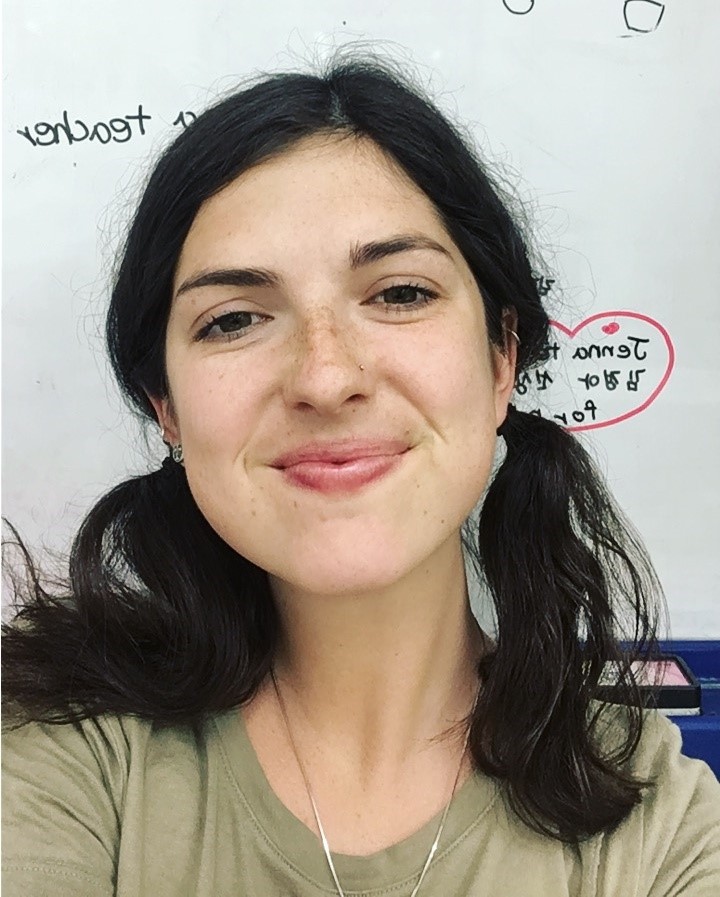 Jenna Kunze is an expat in Seoul, South Korea. She asks a lot of questions, and has been described by third parties as “energetic”. To read about her other (mis)adventures, you can visit her website at www.jennakunze.wordpress.com, or follow her instagram @jennakunze.
Jenna Kunze is an expat in Seoul, South Korea. She asks a lot of questions, and has been described by third parties as “energetic”. To read about her other (mis)adventures, you can visit her website at www.jennakunze.wordpress.com, or follow her instagram @jennakunze.



